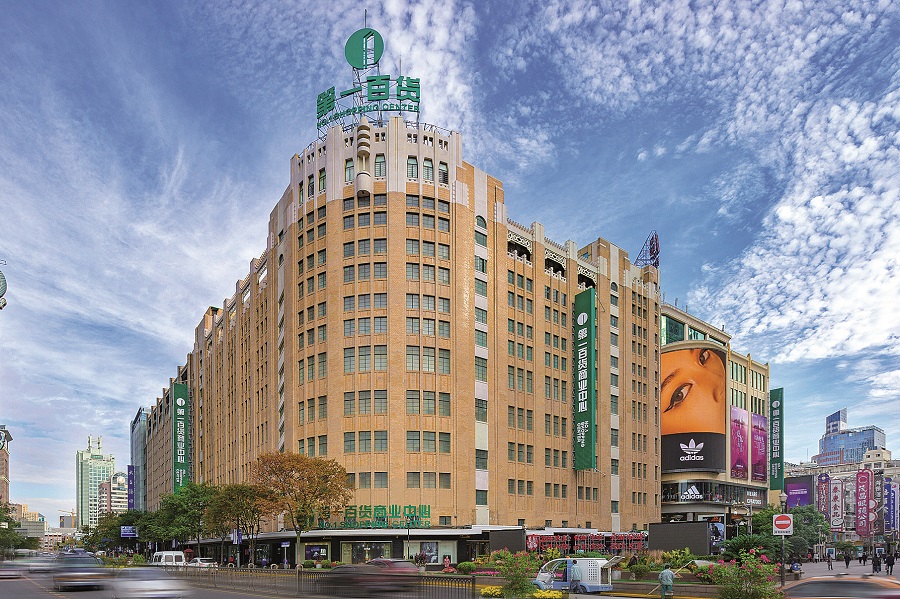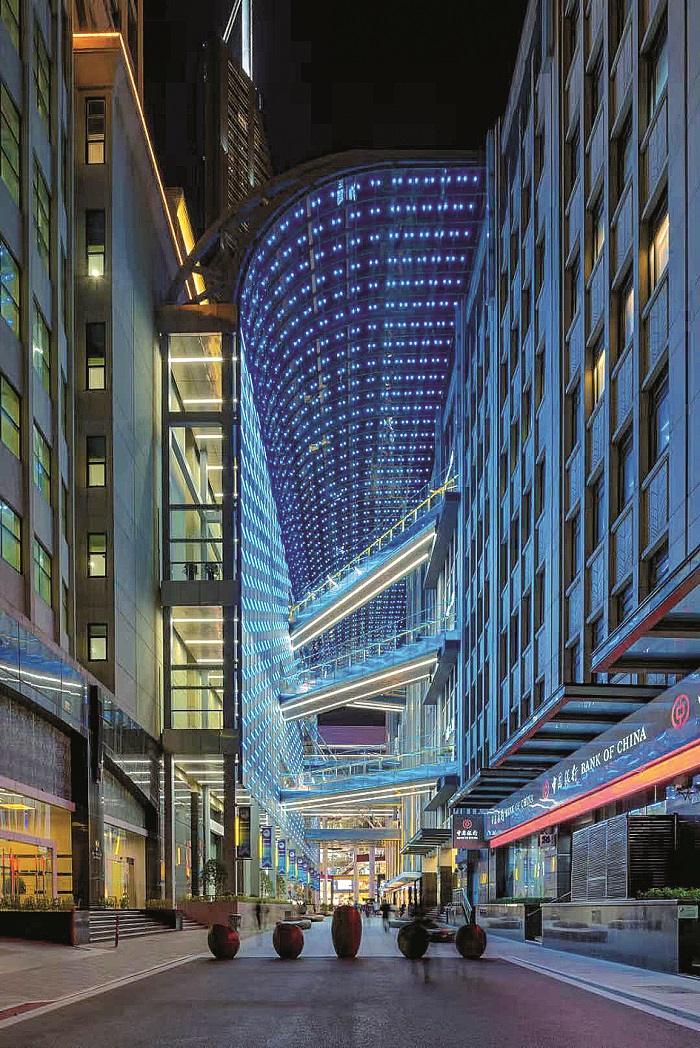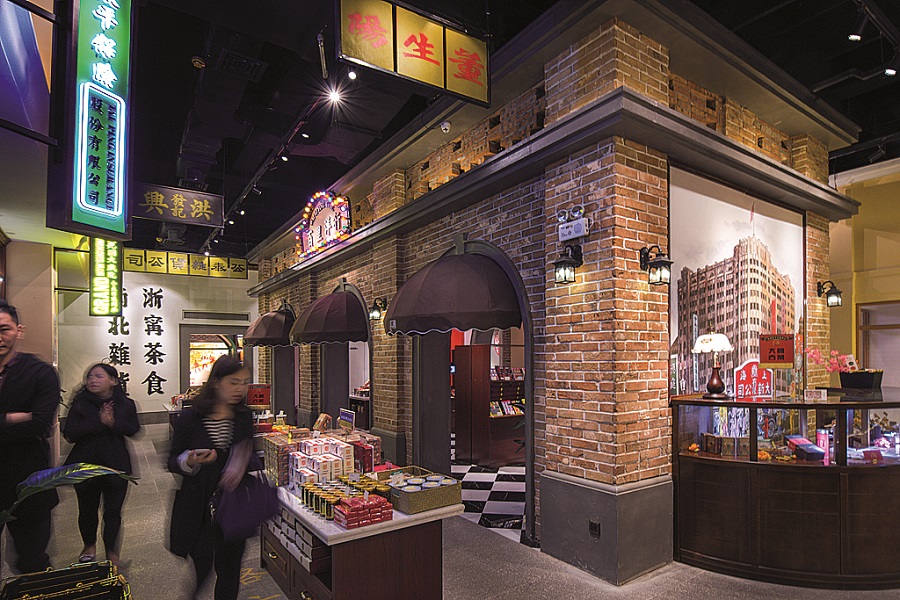The transformation of shopping
By Cao Chen in Shanghai | China Daily | Updated: 2018-12-08 01:06

Women dressed in elegant qipao and high-heels with dainty bags in their hands stand in front of a green and white livery tram along Shanghai’s Nanjing Road, colorful neon signs flickering in the background.
But nothing in this scene is actually real. The women are cardboard figures. The tram is a replica. The scene is actually set above ground and indoors, within a chic new space called Lane 100 that is located on the seventh floor of No 1 Shopping Center on East Nanjing Road, a well-known shopping area in the country.
“It’s thrilling to see popular necessities from the 1900s here, including enamel mugs, old-school Chinese postman’s bikes and manual sewing machines,” said Ke Xiaojie, a Shanghai resident in her 50s.
“I also love the brick and mortar shikumen-style wall design, and how the tunes of Shanghai Nights (a classic song of old Shanghai) are being played in the background, calling back my childhood memories.”
Dedicated to the exhibition of nostalgic goods, Lane 100 is just one of the new offerings in the mall which was reopened in November after 18 months of renovation. The makeover project saw the old No 1 Shopping Center merge with the former Orient Shopping Center just across Liuhe Street.
The move is aimed at drawing younger consumers, as evidenced by the drastic change in featured brands. According to the mall operator, more than 70 percent of the old brands that were once located in the two malls have been replaced with those currently in vogue. Meanwhile, the food and beverage options have been increased from 20 to 38 percent, while more space has been allocated for lifestyle amenities such as hair salons, exhibition zones and child care centers.
According to Fan Liqun, the manager of the shopping center, the average age of its consumers has dropped by about 20 years. Today, the majority of those who visit the mall are aged between 20 and 45.
Formerly known as Da Sun Department Store, this 82-year-old mall has like its many peers in the city embraced the sweeping changes to the retail sector, transforming itself into not just a retail hub but a lifestyle center that is focused on providing real-time experiences for consumers.
“No 1 Shopping Center used to be the mall with the highest sales for 14 consecutive years in Shanghai,” said Fan.
“But this transition it has undergone is obviously inevitable in this day and age. The renovation represents a new evolution of traditional department stores as they try to adapt to the new retailing era.”

Stores through the centuries
According to Song Zuanyou, a former researcher at the Institute of History in the Shanghai Academy of Social Sciences, department stores only became popular around the world in the 1800s following the founding of Le Bon Marche in Paris, France, in 1838.
However, Shanghai was largely isolated from this trend until the 1900s when the city’s economy made great strides forward due to rapid industrial development.
“During this period, people became wealthier and had more purchasing power. This meant that the smaller stores they used to shop at were unable to meet their growing demands,” said Song.
The first department store in Shanghai was built in 1906. Established by the foreign company Whiteaway, Laidlaw & Co and located on Nanjing Road, the five-story building featured more than 20 brands. However, the store did not make much of an impact in the local scene as most of its offerings were imported goods catered to the expatriate population.
In 1917, the Sincere Department Store was founded in Shanghai by the Sincere Company Limited. While this department store also sold pricey global goods, it stood out from the store by Whiteaway, Laidlaw & Co by introducing new functions to the space, such as entertainment options, offices, hotels and a rooftop garden.
Lu Yongyi, a professor from the school of architecture at Tongji University, once said at a seminar in 2016 that the Sincere Department Store was “a unique model that laid the foundations for all shopping malls in the city”.
Following the success of Sincere, Wing On and Sun Sun department stores entered the market a few years later. This trio of retail enterprises dominated the local market for many years to come.
But the entry of the Da Sun Department Store in 1936 broke this monopoly. Established with an initial capital of HK$4 million, the 10-story Da Sun Department Store was equipped with OTIS escalators, a heating and cooling system and underground stores, all of which were firsts in China.
“I still remember that during my days in junior high school in the 1970s, people would go to the mall just to see the escalator,” said Lao Guoling, a 54-year-old Shanghai native.
“During the two decades I spent living in my grandma’s home on Nanjing Road, hanging out at Da Sun Department store was my after-school ritual,” she added.
Despite the ongoing conflict during the War of Resistance against Japanese Aggression (1931-45), business at department stores boomed as a large number of foreigners sought shelter in Shanghai and settled in the international settlement and the former French Concession.
“A new round of transformation for department stores occurred after the war when locals who needed high quality but affordably priced goods drove demand in the city,” said Lao, who is also the director of the E-commerce Research Center at Shanghai University of Finance and Economics.
After the founding of New China in 1949, Da Sun Department Store was replaced by No 1 Shopping Center which offered more local products to consumers.

The rise of shopping malls
The department store industry in Shanghai enjoyed steady growth till the end of the 20th century when it was buoyed by national initiatives such as the Shanghai Urban Master Plan which resulted in rapid urbanization across the city.
“Most residents preferred to stay around the central Huangpu district in the past because the suburban areas did not have much amenities. But people were gradually able to live across the city because of the improvement in living conditions,” said Wang Xudong, a Shanghai native.
To serve the population of these newly urbanized areas, massive shopping malls instead of department stores were added to the landscape. These facilities, such as the Super Grand Mall in Pudong New Area and Grand Gateway 66 in Xuhui district, combined social, commercial and recreational offerings under one roof. Traditional department stores in central Shanghai had in comparison become one-dimensional.
By 1999, business zones in the city hit 20 million square meters, almost quintupling the figure in 1990, according to Chao Gangling, business school professor at Shanghai University of Finance and Economics. However, the number of small- and mid-range department stores had decreased by more than a half. This situation was exacerbated in the mid-2000s when e-commerce emerged.
“It’s convenient when shopping is simply about making a few clicks on the mouse. And then there’s also the allure of discount coupons and delivery service,” said Chao, who is also the vice-chairman of the Shanghai Business Economics Society.
According to the National Bureau of Statistics, the overall size of the nation’s online retail sector was 7.18 trillion yuan ($1.05 trillion) last year, a rise of about 32 percent from the previous year.
But despite talk about how brick and mortar retail businesses might face extinction in the face of e-commerce, Chao believes there will always be a place for offline shopping.
“The unique aspect of a mall is the experience you get from spending time dining, playing or even learning. This experience is something e-commerce cannot offer,” he said.
“There is no need to ‘fight against’ e-commerce. It’s about giving full play to offline advantages,” he added.
The current retail trend supports this sentiment. Old department stores are being transformed into new malls that offer a blend of retail and experiential offerings.
For example, the former Orient Shopping Center along Huaihai Road was turned into a mall that features the world’s largest flagship stores for Under Armour and Muji.
The Pacific Department Store along the same road, which was shut down in 2016, has been transformed into the new Xintiandi Plaza which is slated to open at the end of this year. The new space will feature a host of top global brands, popular restaurants, and an area dedicated to art shows and technology exhibitions. There will also be two rooftop outdoor gardens overlooking the bustling area.
Some branches of traditional stores in Shanghai, like Printemps Department Store, New World Department Store and Orient Shopping Center have also sought to stay relevant in these modern times by introducing new spaces for public events, dining, education and entertainment.
Shanghai had announced a three-year plan earlier this year to build the four brands of the city — services, manufacturing, shopping and culture — to become a shopping hub that will offer the world’s trendiest and most value-for-money products.
The city is also planning to create two world-class shopping streets, 10 local first-class core business districts, and 20 special shopping districts by 2020.
The revitalization of 50 brands with Shanghai characteristics and 50 time-honored brands is also a major part of the project. Traditional stores that are classic icons of Shanghai society, said Chao, will take the lead in this transformation process.
























